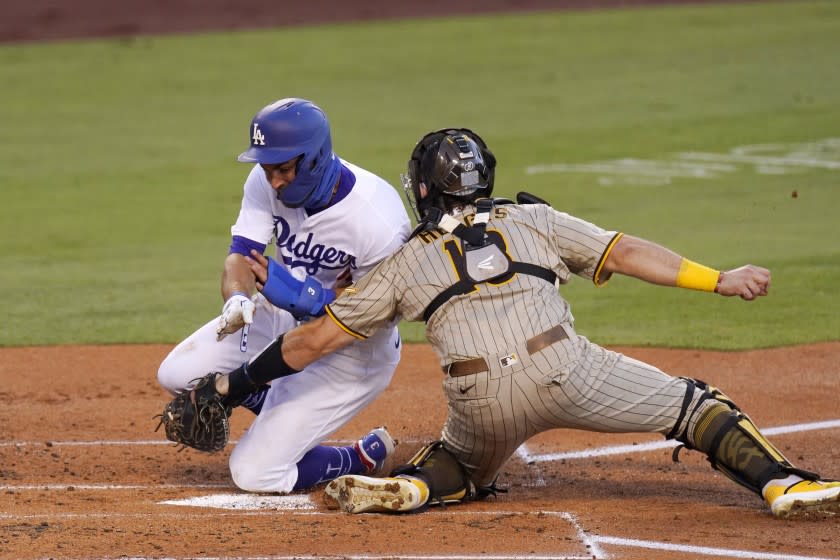Dodgers' offensive struggles are part of a league-wide trend this season

The San Diego Padres arrived in Los Angeles for a four-game series this week against the Dodgers intent on leaving an impression. They strive to be considered a real playoff contender. They want the Dodgers to sense the National League West isn’t a given. After dropping two of three in San Diego last week, they sought to prove they can compete with the division’s bully.
They’re making their point through two games, beating the Dodgers 6-2 on Tuesday for the second straight night at Dodger Stadium as the Dodgers’ offense continues to sputter.
The Dodgers gifted their visitors a five-run third inning with throwing errors on back-to-back sacrifice bunts. Starter Ross Stripling sailed a throw over first base for the first error. Third baseman Justin Turner then made an errant on-the-run throw charging Jurickson Profar’s bunt.
Manny Machado soon capitalized by swatting a grand slam against his former team. The Dodgers couldn’t recover. They didn’t score again until the ninth inning. They’ve totaled three runs in the series’ first two games.
“Honestly, I don’t think the scoreboard was indicative of our at-bat quality, of our intent,” Dodgers manager Dave Roberts said. “We squared a lot of balls up tonight. I really, really loved the fight, the compete in the batter’s box. We just got to continue to stay the course.”
The Dodgers entered Tuesday tied for the fifth-highest win percentage in the majors. They were half a game behind the Colorado Rockies for first place in the National League West. They are in position to reach the expanded postseason more than a quarter through this 60-game frenzy.
And yet they began the day batting .229 collectively. No team in franchise history has posted a batting average that low in a season since the Brooklyn Superbas batted .229 in 1910. They had as many players in their starting lineup Tuesday batting .300 as they had batting under .100 (one).
So how did the Dodgers win 11 of 17? Well, because the bullpen is outperforming expectations, they slugged home runs in opportune spots, and the hitting woes aren’t limited to them.
Adding the designated hitter at NL ballparks was supposed to boost half of the teams’ offenses, but the 30 clubs have combined for the second-worst collective on-base-plus-slugging percentage in the last decade and the collective batting average across the majors is the lowest since 1968. The Padres, for example, were batting .236 entering Tuesday. The Cleveland Indians were last at .196 — and still were 10-7 before losing Tuesday.
There are multiple reasons for the decline.
First, hitters have combined for the highest strikeout rate of all time. Second, infield shifts have increased across the league. As a result, the batting average for ground balls by left-handed hitters dropped to .182 from .231 in 2017. Overall, 27.6% of balls in play are hits, the lowest number since 1972. The Dodgers have contributed to those numbers: They were third in shifting and deployed the most shifts against left-handed hitters at over 80% entering Tuesday.
Roberts pointed to another variable: Managers are deploying pitchers aggressively with more relievers available because of expanded rosters. Teams are not as often letting starters face a lineup a third time — when most encounter their biggest trouble. Hard-throwing relievers are streaming out of bullpens for one-inning appearances. The constant new looks put hitters at a disadvantage.
It’s a style of baseball often played in the postseason when more days off are baked in and just four, if not three, starting pitchers are needed.
“There are more guys in the ’pen so managers are matching up more,” Roberts said. “And there’s a lot of big power arms in ’pens across the league. … And, also, I would assume typically in a season, pitchers start a little bit ahead of hitters and then they start to catch up.”
Unable to consistently string together hits, the Dodgers have relied on the home run to generate offense. Entering Tuesday, 47 of their 88 runs (53.4%) were scored via the home run. The rate ranked fifth in the majors. After Tuesday, home runs have produced 20 of their 28 runs.
“I think that’s kind of an end result of having good at-bats and working counts and them making mistakes,” Dodgers shortstop Chris Taylor said. “That’s not something we really stress. We’re just trying to make the pitcher work, have good at-bats — especially when you’re facing some of those top-end-of-the-rotation pitchers.
“You’re not going to be able to slug your way to a win every time. You’re going to have to have good situational hitting and good at-bats. And if you run into a couple, then great.”
The Dodgers didn’t run into any Tuesday, and the offense stumbled again.
THREE OBSERVATIONS
Ross Stripling gave up six runs, two earned, across 42/3 innings in his second start against the Padres in less than a week. It was the shortest of Stripling’s four outings this season.
Dave Roberts said Tony Gonsolin will be recalled from the team’s alternate training site to start Wednesday. Julio Urías, originally scheduled to pitch Wednesday, will start Thursday.
Justin Turner recorded his 1,000th career hit with a double in the second inning. The third baseman set the franchise career record for being hit by pitches earlier this month.

